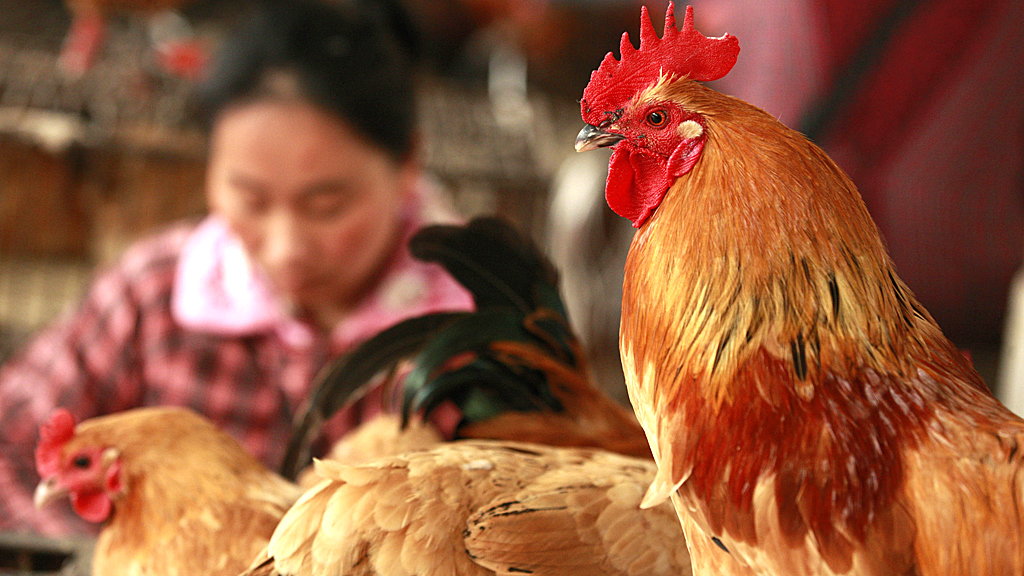China announces four new cases of bird flu
Four new cases of a strain of bird flu are reported in China, though health experts say there is no evidence that the virus can be transmitted between people.

The H7N9 strain previously unrecorded in humans has already killed two people, taking the total of unknown cases to seven, writes Asha Tanna. But scientists say this is a less virulent form of bird flu.
The four new patients in China’s eastern Jiangsu province were all in critical condition and receiving emergency treatment, the Xinhua News Agency said, citing the Jiangsu provincial health bureau. A fifth patient, a woman in Anhui province who caught the virus in early March, is also in critical condition.
The Chinese news website Chinanews.com said the four patients in Jiangsu – a province next to Shanghai – were aged between 32 and 83 and only one, a 45-year-old woman, had worked in the market slaughtering poultry. All four reported varying symptoms of dizziness, fever, cough and breathlessness.
The two deaths earlier this year were men in Shanghai aged 87 and 27 who fell ill in late February. It is not known how the seven victims were infected, though the government believes the virus is not highly contagious.
Wu Fan, chief doctor and director general of the Shanghai Municipal Centre for Disease Control, said that the government had acted as quickly as it possibly could. She said: “In this situation, to take 20 days to identify and confirm a new virus is already considered short.
“We cannot say for certain or confirm if it was a case of a human catching an avian virus or an avian virus changing and becoming a new human flu virus.”
Potential threat?
According to Xinhua News Agency 43 people have been in contact with the four most recently infected patients, but none of these individuals shows symptoms of respiratory problems or fever, or is currently under medical observation. So far, the World Health Organization (WHO) says there is no indication of human-to-human transmission.
Ian Jones, a professor of virology at Britain’s University of Reading, said at this stage there was no cause for alarm. He said: “At the moment I don’t think it’s anything more than an unusual set of isolated cases.”
He added that three types of avian influenza – H5, H7 and H9 – were considered by experts to be a potential threat to humans.
Since there is no evidence to date of human-to-human transmission, or of clusters of cases around those few confirmed so far, Professor Jones said authorities should be watchful but need not enact emergency measures.
“Of course we need to take account of these cases and follow up the contacts and so on, but I think that’s where it rests at the moment,” he said. “It’s far too soon to assume this is the start of something.”
Poor record
Most forms of avian influenza do not infect humans, with notable exceptions, like the H5N1 strain that has claimed over 300 lives worldwide after an outbreak spread from infected poultry in Asia in 2003. But even H5N1 didn’t pass easily from one person to another, and the majority of people who fell ill had contact with contaminated poultry.
But China has a poor record when it comes to dealing with bad news quickly. In the past it has been guilty of cover ups by officials who fear it may attract unwanted attention from superiors and damage promotion prospects, despite government efforts to enhance transparency.
In 2003, Beijing initially tried to cover up the epidemic of severe acute respiratory syndrome (SARS), which emerged in China and killed about a tenth of the 8,000 people it infected worldwide. Some Chinese have complained that authorities took too long before announcing the deaths on Sunday, although the WHO says the government acted properly.
-
Latest news
-
Trump hush money trial: Defence gives closing arguments4m

-
‘Children should be educated with survival skills’, says Leeds Young Conservatives chairman3m

-
The Estonian teenagers training for conflict and crisis5m

-
‘There’s an overwhelming sense of fear and panic,’ in Rafah says Red Cross3m

-
Israel Hamas war: Tanks move into central Rafah as thousands flee3m

-




